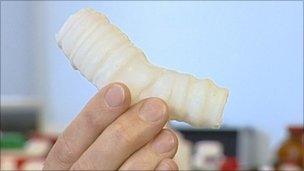First synthetic organ transplant
- Published
- comments

Synthetic trachea
I've held a few strange body parts in my hands over the years - all I should stress, in the line of work. They have ranged from mechanical heart pumps to hi-etch prosthetic limbs.
But none more life-like than the synthetic trachea manufactured by scientists from University College London, external. The team, lead by Professor Alex Seifalian, have patented a nanocomposite material which was used to create the first completely synthetic windpipe.
It was transplanted into a patient whose own windpipe was damaged by cancer. The operation was done in Sweden at the Karolinska University Hospital, external in conjunction with the Karolinska Institute. You can read the background to the story by my colleague Michelle Roberts, who interviewed the patient and the surgeon in Stockholm.
Pioneering
I visited the London end of this international collaboration, at the labs at the Royal Free Hospital in Hampstead, where the trachea was made.
One of the keys to the synthetic windpipe is its structure which contained millions of tiny holes. This was important during the two days that the windpipe spent in a revolving bio-reactor.
Nanocomposite
The bio-reactor contained adult stem cells taken from the patient's bone marrow. The nanocomposite material of the windpipe had a huge surface area and its porous nature allowed it to be seeded by the patient's tissue.
In effect, a synthetic windpipe became the patient's own.
The surgery was carried out on 9th June and the patient is being discharged on Friday. Clearly, it is still early days, but if he makes a good recovery then it marks another successful pioneering step in the history of transplantation.
Professor Macchiarini summed up the importance of this new technique.
"The material can be made quickly and you have no need of a donor," he said.
"This avoids waiting. Also there is no requirement for anti-suppressant drugs."
There have been transplants before without donors. Several patients have received replacement bladders grown from their own stem cells. There have been artificial mechanical hearts which have assisted failing organs.
Three years ago Professor Macchiarini gave a woman in Spain a new windpipe which was seeded by her own stem cells. But that involved a donor windpipe which was stripped down to cartilage.
This technique does away with the need for donors and the tissue can be created rapidly in the lab.
Alex Seifalian, Professor of Nanotechnology and Regenerative Medicine at UCL, whose research is funded by the Wellcome Trust, has big plans for his synthetic tissue. He showed me a machine which, in just 20 minutes, can create a metre long synthetic tube.
"The material pulses like an artery and we can make it different diameters" he said. "We plan to use it for arteries, larger structures like aorta and it could even be used to create an ear, nose or replacement skin."
The next collaboration between Professor Seifalian and the surgeon, Professor Paolo Macchiarini, involves creating a windpipe for an 11-month-old girl from South Korea, who was born with a rare abnormality which prevented her trachea from growing.
The surgery is likely to take place in the US later this year.